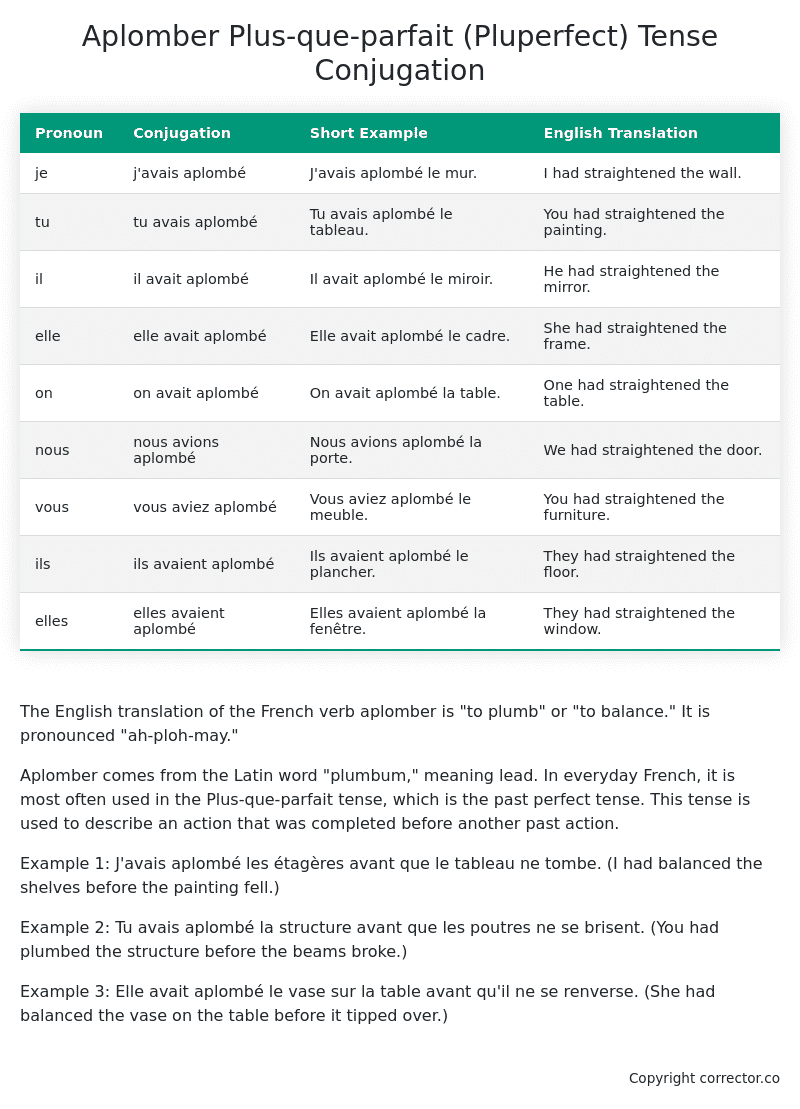Plus-que-parfait (Pluperfect) Tense Conjugation of the French Verb aplomber
Introduction to the verb aplomber
The English translation of the French verb aplomber is “to plumb” or “to balance.” It is pronounced “ah-ploh-may.”
Aplomber comes from the Latin word “plumbum,” meaning lead. In everyday French, it is most often used in the Plus-que-parfait tense, which is the past perfect tense. This tense is used to describe an action that was completed before another past action.
Example 1: J’avais aplombé les étagères avant que le tableau ne tombe. (I had balanced the shelves before the painting fell.)
Example 2: Tu avais aplombé la structure avant que les poutres ne se brisent. (You had plumbed the structure before the beams broke.)
Example 3: Elle avait aplombé le vase sur la table avant qu’il ne se renverse. (She had balanced the vase on the table before it tipped over.)
Table of the Plus-que-parfait (Pluperfect) Tense Conjugation of aplomber
| Pronoun | Conjugation | Short Example | English Translation |
|---|---|---|---|
| je | j’avais aplombé | J’avais aplombé le mur. | I had straightened the wall. |
| tu | tu avais aplombé | Tu avais aplombé le tableau. | You had straightened the painting. |
| il | il avait aplombé | Il avait aplombé le miroir. | He had straightened the mirror. |
| elle | elle avait aplombé | Elle avait aplombé le cadre. | She had straightened the frame. |
| on | on avait aplombé | On avait aplombé la table. | One had straightened the table. |
| nous | nous avions aplombé | Nous avions aplombé la porte. | We had straightened the door. |
| vous | vous aviez aplombé | Vous aviez aplombé le meuble. | You had straightened the furniture. |
| ils | ils avaient aplombé | Ils avaient aplombé le plancher. | They had straightened the floor. |
| elles | elles avaient aplombé | Elles avaient aplombé la fenêtre. | They had straightened the window. |
Other Conjugations for Aplomber.
Le Present (Present Tense) Conjugation of the French Verb aplomber
Imparfait (Imperfect) Tense Conjugation of the French Verb aplomber
Passé Simple (Simple Past) Tense Conjugation of the French Verb aplomber
Passé Composé (Present Perfect) Tense Conjugation of the French Verb aplomber
Futur Simple (Simple Future) Tense Conjugation of the French Verb aplomber
Futur Proche (Near Future) Tense Conjugation of the French Verb aplomber
Plus-que-parfait (Pluperfect) Tense Conjugation of the French Verb aplomber (this article)
Passé Antérieur (Past Anterior) Tense Conjugation of the French Verb aplomber
Futur Antérieur (Future Anterior) Tense Conjugation of the French Verb aplomber
Subjonctif Présent (Subjunctive Present) Tense Conjugation of the French Verb aplomber
Subjonctif Passé (Subjunctive Past) Tense Conjugation of the French Verb aplomber
Subjonctif Imparfait (Subjunctive Imperfect) Tense Conjugation of the French Verb aplomber
Subjonctif Plus-que-parfait (Subjunctive Pluperfect) Tense Conjugation of the French Verb aplomber
Conditionnel Présent (Conditional Present) Tense Conjugation of the French Verb aplomber
Conditionnel Passé (Conditional Past) Tense Conjugation of the French Verb aplomber
L’impératif Présent (Imperative Present) Tense Conjugation of the French Verb aplomber
L’infinitif Présent (Infinitive Present) Tense Conjugation of the French Verb aplomber
Struggling with French verbs or the language in general? Why not use our free French Grammar Checker – no registration required!
Get a FREE Download Study Sheet of this Conjugation 🔥
Simply right click the image below, click “save image” and get your free reference for the aplomber Plus-que-parfait tense conjugation!

Aplomber – About the French Plus-que-parfait (Pluperfect) Tense
Tense Formation
Common everyday usage patterns
Sequencing of past events
Background information
Hypothetical or reported speech
Interactions with other tenses
Summary
I hope you enjoyed this article on the verb aplomber. Still in a learning mood? Check out another TOTALLY random French verb conjugation!


